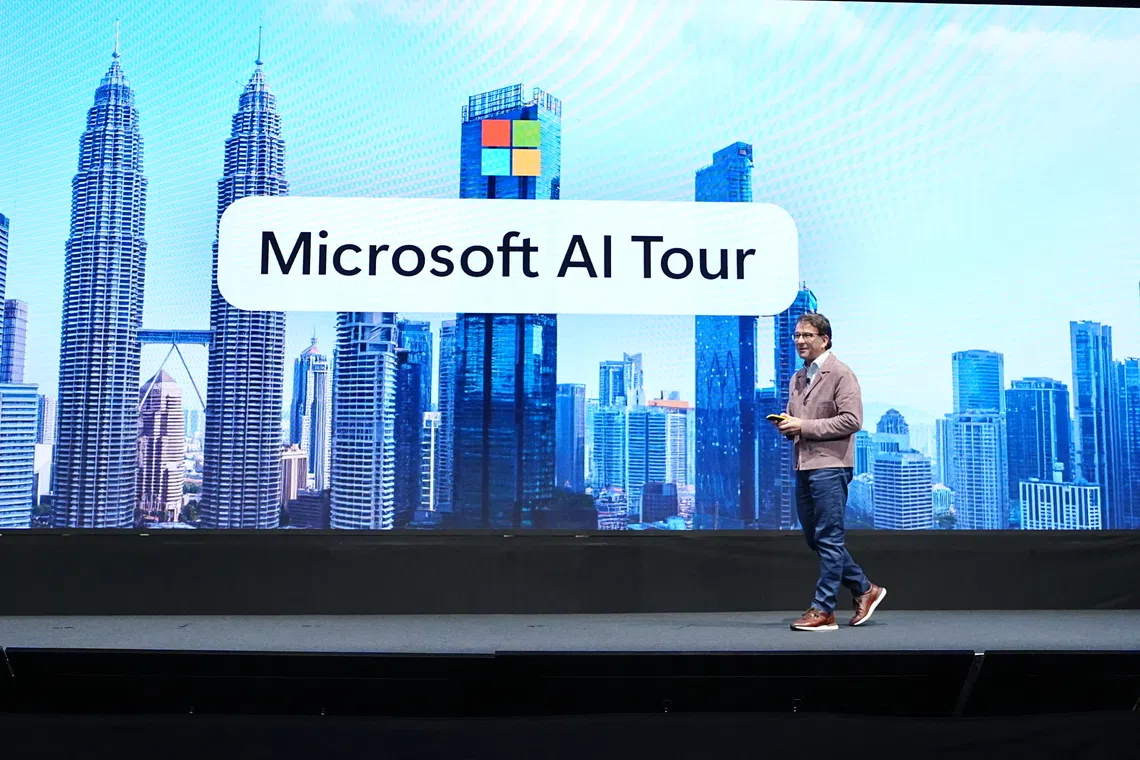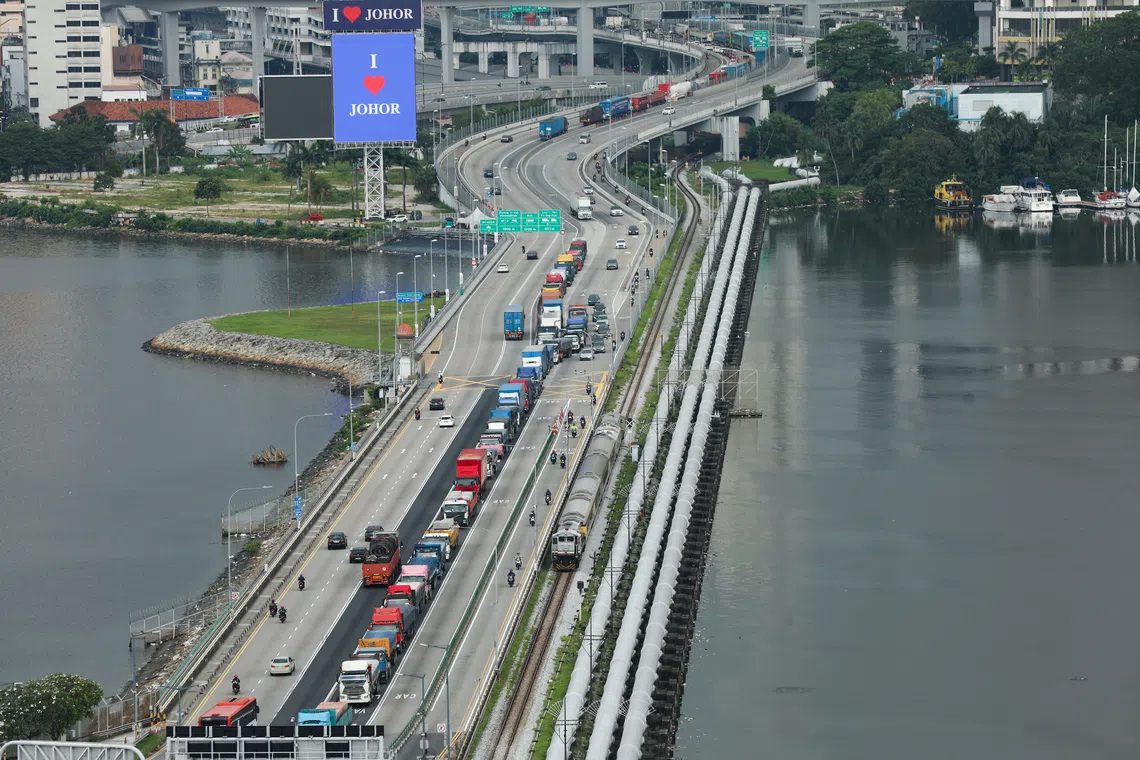Microsoft launches second cloud region in Johor Bahru, boosting Malaysia data-centre development
This cloud region aims to support regional-scale workloads, multinational users and data-intensive AI systems

[KUALA LUMPUR] Microsoft on Tuesday (Nov 4) unveiled plans for Southeast Asia 3, its second cloud region in Malaysia, to be developed in Johor Bahru as part of the tech giant’s US$2.2 billion investment in the country.
Laurence Si, managing director of Microsoft Malaysia, said the new region will deliver Microsoft’s most comprehensive cloud and artificial intelligence (AI) services to date, and support the rapidly rising demand for secure, scalable computing across the public and private sectors.
The expansion strengthens Malaysia’s position as a strategic hub for advanced computing and AI infrastructure in South-east Asia, he said.
The project falls under Microsoft’s US$2.2 billion, four-year investment plan announced in May 2024. It is the company’s largest single commitment in Malaysia to date.
The investment is progressing on schedule, said Si, but he declined to reveal the timeline of the development.
Microsoft unveiled the first cloud region in the country in May. Named Malaysia West, it comprises three data centres in Greater Kuala Lumpur, and set up a national foundation for cloud adoption and digital innovation.
Southeast Asia 3 in Johor Bahru represents the next phase, targeted at regional-scale workloads, multinational users and data-intensive AI systems, Si added.
The new cloud region will be connected to Microsoft’s global Azure backbone network, spanning more than 600,000 km of subsea and terrestrial fibre.
The region is being developed with renewable biofuel-powered backup systems, closed-loop zero-water cooling to minimise water usage, rainwater harvesting systems in Johor schools, and local mangrove ecosystem restoration to support local ecology and coastal resilience.
SEE ALSO
Si said Southeast Asia 3 is designed to support the next wave of AI-driven growth in South-east Asia. As Microsoft’s second data centre region in Malaysia, it is part of a broader Asia infrastructure road map which includes Azure region launches in Malaysia and Indonesia in 2025, and planned expansions in India and Taiwan in 2026.
Microsoft’s land expansion in Johor

Microsoft has been actively expanding its land footprint in Johor to develop data centre infrastructure through multiple strategic acquisitions in the last two years.
In June 2024, the tech giant acquired a 123 acre site in Kulai’s Eco Business Park VI from EcoWorld for RM402.3 million (S$124.9 million). This site is slated for data centre development as part of Malaysia’s growing digital transformation.
In February 2025, it signed a conditional agreement to purchase a 138.5 acre parcel in Tebrau’s Eco Business Park I from EcoWorld for RM693.96 million, further solidifying its presence in Johor.
From Crescendo Corp, Microsoft completed several land purchases including a 22.5 acre plot in the Nusa Cemerlang Industrial Park in Johor Bahru’s Pulai district for RM119.8 million in January 2025.
AI adoption still uneven among the people

Judson Althoff, chief executive officer of Microsoft’s commercial business, said Malaysia is moving faster than many markets in workplace AI use.
“Eighty-four per cent of knowledge workers in Malaysia have already used AI – materially higher than the global average,” he said during the Microsoft AI Tour in Kuala Lumpur, which attracted more than 1,700 participants.
“It shows Malaysians are eager to apply AI in the workplace and are already experimenting with ways to enhance productivity and problem-solving.”
However, a gap exists between workplace adoption and its use by the general public. Among the broader population, only around a quarter actively engage with AI tools, despite more than 60 per cent expressing interest and awareness.
Althoff suggested that the hesitancy is rooted in uncertainty rather than resistance.
“More than 70 per cent of Malaysians say they are excited about AI, but over 60 per cent worry about whether the technology will replace their jobs or whether they can learn fast enough to adapt,” he said.
He noted that bridging this divide requires making AI accessible through tools people already use daily, such as productivity suites, communication platforms and workplace collaboration systems.
“The key is to let AI show up in familiar environments. That removes intimidation and builds confidence,” he said.
A multi-hub strategy, not competition

Mayank Wadhwa, president of Microsoft Asean, said the expansion in Malaysia should be viewed as part of a coordinated effort to establish a connected cloud and AI backbone across South-east Asia, rather than as a competition between countries.
“We don’t see this as a competition. It’s not a zero-sum game,” he told The Business Times in an interview.
“Singapore has been one of Microsoft’s earliest and most important regional data centres. What we are building now is a set of interconnected hubs across South-east Asia to serve customers as the cloud and AI economy scales,” he added.
Wadhwa said Microsoft’s decisions on where and how to expand are shaped by long-term ecosystem planning, and factors in, for example, the availability of land, access to power, construction feasibility and the concentration of enterprise demand.
“It’s a detailed, multi-year assessment of how infrastructure, industry and talent will evolve. We build where the region needs capacity, not where it creates rivalry,” he said.
Wadhwa also noted that data centres play a broader economic role than is often recognised. The multi-billion ringgit investment stimulates domestic supply chains, including those in engineering, logistics, electrical systems and building services.
In parallel, Microsoft is scaling workforce development programmes, with a goal of training around 800,000 Malaysians in AI skills as part of Malaysia’s national digital blueprint, alongside 2.5 million people across South-east Asia.
Microsoft has already trained more than 700,000 Malaysians in AI-related skills and remains on track to reach 800,000 by the end of 2025 under the AIForMYFuture initiative. This sits within the broader Bina AI Malaysia framework and the National AI Innovation Center, set up in partnership with EY, the National AI Office and the Petronas Leadership Centre.
The joint development of an AI-powered financial literacy and retirement planning platform for the 16 million members of the Employees Provident Fund is a flagship project.
“What excites me most is how jobs will evolve,” he said. “Three years ago, prompt engineering wasn’t a job. Now it’s everywhere. The jobs of the next five years will be very different, and we are preparing for that today.”
Wadhwa described Asean as one of Microsoft’s strongest growth engines globally. “Asean isn’t just participating in the AI transformation, it is leading it,” he said.
“Microsoft will succeed in the next five to 10 years only if Asean and Asia succeed. We are very bullish on this region. Our success is tied to its success,” he added.
Johor’s rise as a regional data centre growth frontier

The timing of Southeast Asia 3 aligns with Johor’s transformation into one of Asia’s fastest-growing data centre markets. The state has benefited from the demand spillover from Singapore, its competitive land and power costs, and improvements in connectivity via the Johor-Singapore Special Economic Zone.
Credit rating agency Fitch Ratings projects a massive increase in Johor’s operating capacity, potentially reaching 5,000 megawatts (MW) by 2029, up sharply from just 10 MW in 2021.
At a webinar in August, Sajal Kishore, Fitch Ratings’ head of Asia-Pacific infrastructure and project finance ratings, listed the state’s significant competitive advantages. “Johor has essential resources such as land, water and power, and provides these at a significantly lower cost.”
Hyperscalers and major operators have anchored this growth momentum. Amazon Web Services has committed RM25.5 billion to its Malaysia cloud region.
YTL is developing a 500 MW solar-powered data centre park in Kulai, and ST Telemedia Global Data Centres is building a 120 MW facility in the state. Demand remains particularly strong from AI workloads, cloud-native platforms and compute-intensive applications.
Decoding Asia newsletter: your guide to navigating Asia in a new global order. Sign up here to get Decoding Asia newsletter. Delivered to your inbox. Free.
Copyright SPH Media. All rights reserved.






